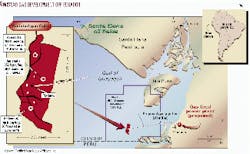Development of a gas field in the Tumbes basin off Ecuador designed to support a power plant has yielded positive initial results.
The first development well in a four well program at Amistad gas field cut thicker gas pay than expected, and the second well is drilling.
Noble Affiliates Inc., Ardmore, Okla., operates the project and holds 100% working interest through subsidiaries Samedan Oil Corp. and EDC Ecuador Ltd.
Noble booked 87.5 bcf of gas reserves associated with Amistad field in 1999 and will add more reserves this year if drilling results go as expected. In fact, Noble Chairman, President, and CEO Robert Kelley told an investment conference in Houston in late September that he expects to see "significant upward booking" of the Ecuadoran gas reserves during 2001.
Kelley told the analysts that while Ecuador hasn't been the most stable country politically or economically, the situation there has improved from a year ago and the "dollarization" of its currency has proven successful.
Noble intends to build a 40-mile pipeline to transport Amistad gas to a power plant at Machala, Ecuador. The company looks forward to cash flow of $32 million/year from the power plant and $534 million project net cash flow over the plant's life.
Development drilling
Noble recently expressed better than expected results from the first of four wells to be drilled from the Amistad platform at a combined cost of $78 million.
Amistad 5 encountered 341 ft of net gas pay as determined from electric logs. Stout pressures caused control problems for a time, and Noble did not test the well. The pay thickness compared favorably with the three wells the Ada Oil Exploration group drilled upon discovering the field in the early 1970s (Amistad 1, 3, and 4).
Amistad 5 is more than a mile southwest of Amistad 1, which cut 352 ft of pay and tested 28.5 MMcfd from just 38 ft of formation. Amistad 5's TD is 10,900 ft.
The platform is in 130 ft of water in the Gulf of Guayaquil about 5 miles north of Peruvian waters. Amistad 7 was drilling in late September.
The field would supply about 13 bcf/year of gas to the $140 million, 200-Mw combined-cycle power plant at Machala during 20 years. The project is to start up early in 2002.
Noble estimated power demand at 2,900 Mw/year in Ecuador and a constrained 80 Mw/year in Machala. Noble's generators would provide power to Machala and the national grid.
More potential
Its 2D and 3D seismic data indicate other structures with potential on the block, Noble said, but it will develop Amistad before exploring the other possibilities. Hydrocarbon potential is known in other areas of the Tumbes-Progreso basin in Peru and Ecuador.
Zuniga-Rivero et al., discussing Peruvian possibilities, noted in 1998 that on the northwesterly side of the Dolores megashear the Progreso sub-basin wraps around the productive area of the Santa Elena Peninsula, which is on a pre-Neogene high. The Progreso sub-basin covers about 5,000 sq miles and lies entirely within Ecuador (see maps, OGJ, Oct. 19, 1998, p. 88).
Landward from the shear zone, the Tumbes sub-basin extends up the coast from northern Peru into Ecuador.
"It takes in the shallow nearshore waters, including Amistad gas field. Amistad reserves are in the Miocene Subibaja formation-up to 400 net ft of conglomeratic sandstone at around 10,000 ft. The productive area of the field is about 6,400 acres, and the estimated gas reserves exceed 1 tcf," Zuniga-Rivero et al. reported.
"Natural gas in commercial quantities has also been discovered in Peru, but-like Amistad-the five discoveries have yet to be developed because there has been no market for the gas. The onshore Peruvian sector of the sub-basin includes the old Zorritos oil field, discovered in 1863 and produced continuously until 1965. The reservoir here is the Miocene Zorritos sandstone, which yielded final cumulative production of 4 million b/d of light crude. In both sub-basins Mio-Pliocene clastics are underlain by Paleogene and Cretaceous strata that in places rest on Paleozoic basement."
Delayed development
Amistad gas field has a history of false starts.
The former Ada Oil Exploration group discovered Amistad in 1970, when the country had no gas infrastructure. The government canceled its concession 2 years later because of alleged title defects.
Ada had estimated gas in place at 4 tcf on a large block surrounding and including Amistad.
Broken Hill Pty. Co. Ltd. and King Ranch Inc. attempted unsuccessfully to establish a project in the area in the mid-1990s (OGJ, Oct. 17, 1994, p. 48).


